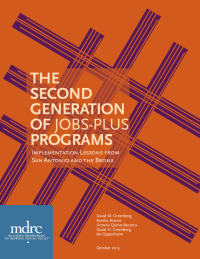The Second Generation of Jobs-Plus Programs
Implementation Lessons from San Antonio and the Bronx

The Jobs-Plus Public Housing Revitalization Initiative (1998-2003) was designed to raise and sustain the employment and earnings of residents of public housing developments. It had three parts: (1) employment services offered at on-site job centers, (2) changes in rent rules that provide financial incentives to work, and (3) community support for work through neighbor-to-neighbor conversations. The initiative was subject to a rigorous evaluation, which found that where implemented fully, Jobs-Plus boosted residents’ annual earnings by 16 percent, or $1,300 per year, an effect that endured seven years without abating. This report investigates how Jobs-Plus was replicated in more contemporary settings, analyzing the early implementation experiences of a community-based provider in the Bronx and the San Antonio Housing Authority in Texas, both funded by the Social Innovation Fund (SIF) of the Corporation for National and Community Service.
Main Findings
-
Providers in the Bronx and in San Antonio were able to enroll substantial proportions of residents of very large housing developments. This represents a strong early indication of program “saturation,” or offers of services. At the same time, providers found that the three components of Jobs-Plus — and especially their integration and coordination with each other — were difficult to manage in practice. Both providers generally placed residents in low-wage work, and struggled to find ways of helping residents who were already employed.
-
Rent-based financial incentives were very seldom used by Jobs-Plus members, for reasons largely out of the control of program implementers. In the original demonstration, housing authorities could develop a variety of rent incentives, because they had legal authority to do so. However, in the SIF version of Jobs-Plus, the only rent incentive available to the providers in both the Bronx and San Antonio was the Earned Income Disregard (EID). During early implementation, EID receipt was very low (at about 1 percent of residents in the Bronx and 3 percent in San Antonio), despite providers’ extensive efforts to promote its use.
-
Jobs-Plus cost $672 per household per year in the Bronx and $503 in San Antonio. These costs would likely have increased had residents made greater use of the EID.
-
In the SIF version of Jobs-Plus, neither the community-based organization nor the housing authority appeared to have a clear advantage in providing services. Instead, organizations’ ability to implement the program appeared to depend on their administrative flexibility, their front-line staff members’ ability to work as a team, their ability to tailor their strong workforce development experience to a variety of participants, their ability to conduct vigorous outreach and marketing, and the strength of their connection to property managers.
- The Jobs-Plus “Collaborative,” a support and accountability body made up of local city agencies involved in workforce services, income support, and other social services, emerged as an important entity promoting strong implementation in the Bronx.






